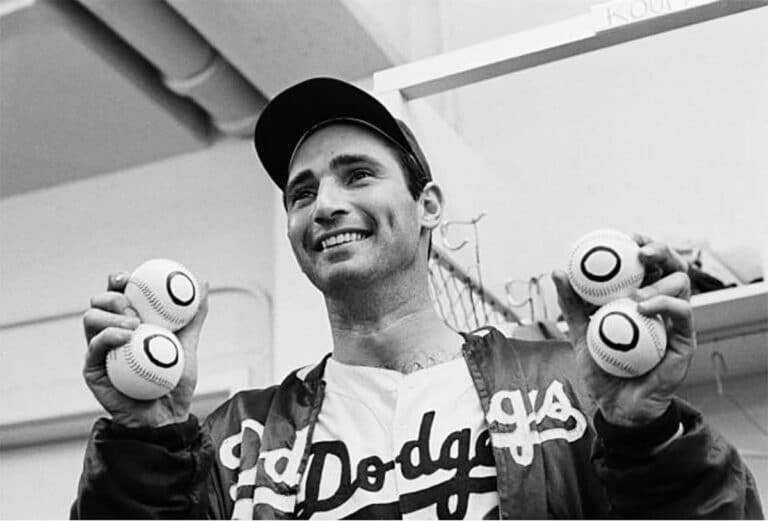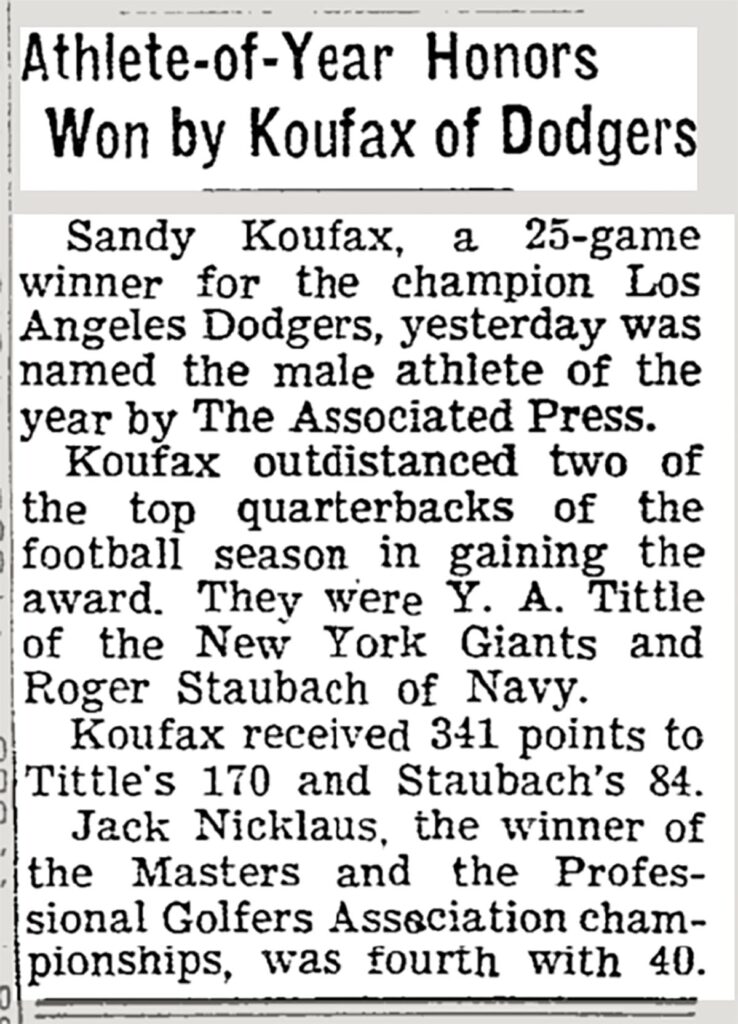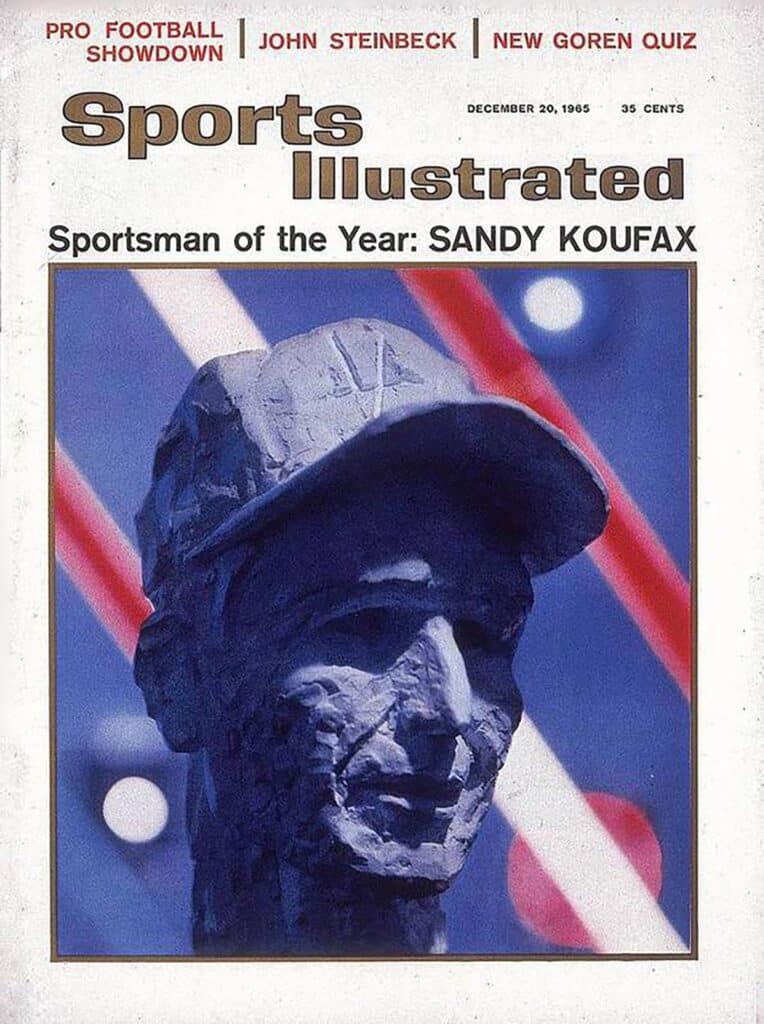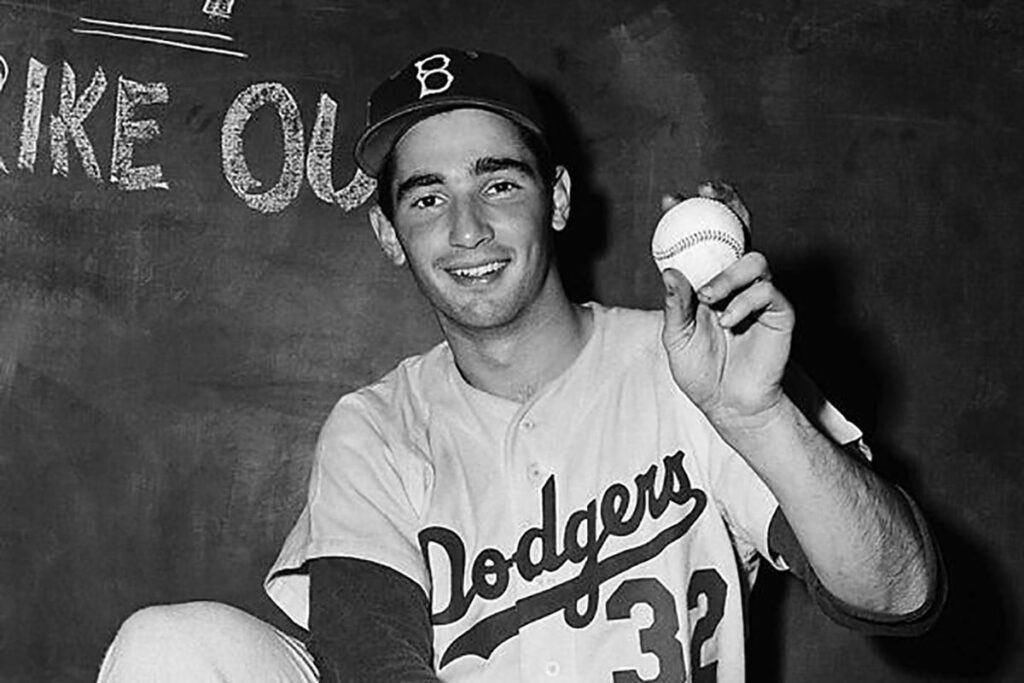
Editor’s note: In honor of Jewish American Heritage Month, we’re spotlighting the positive contributions of Jewish Americans across industries. Stay tuned for more articles on extraordinary Jewish Americans coming soon!
If there’s one Jewish American baseball player to know — it’s Sandy Koufax.
Dubbed “The Left Arm of God” for his pitching accomplishments, Koufax, now 87 years old, is the first pitcher to win three unanimous selections for the Cy Young Award — given annually to the best pitchers in MLB — in 1963, 1965 and 1966.
He was also a Triple Crown winner — meaning he led the National League in wins, strikeouts and earned runs — in each of those years. The Brooklynite was also named the top male American athlete of the year in 1963 when he was honored with the S. Rae Hickok Professional Athlete of the Year award.

In his 11-year career with the Dodgers from 1955-66, Koufax led his team to four World Series wins in both Brooklyn and Los Angeles, where the team moved in his third season. In fact, whenever he pitched, there were around 10,000 more fans in the stands to cheer him on.
Aside from being named one of the greatest aces in baseball history, Koufax is remembered most for his actions on Yom Kippur 1965.
So, here’s everything we know about Koufax’s Jewish identity.
The basics
Sanford Braun was born on Dec. 30, 1935, in Brooklyn to Evelyn and Jack Braun, Sephardic Jews of Hungarian descent. When he was three, his parents divorced and his mother later married attorney Irving Koufax.
Irving took the young Koufax and his older stepsister Edith to Yiddish theater shows in New York City and encouraged him to play basketball and baseball.
Although Koufax grew up in a more secular Jewish household, the family resided in Jewish neighborhoods in Brooklyn and Long Island. He celebrated the Jewish holidays with his family and famously refused to work on them (more on that later).
Koufax’s legendary baseball career had Jewish roots
Believe it or not, Koufax’s first love wasn’t baseball, but was actually basketball. He joined his local community center team at the Edith and Carl Marks Jewish Community House of Bensonhurst, Brooklyn.
At his primarily-Jewish public high school, Lafayette High School, he was their star basketball player. In the spring, he played on Lafayette’s baseball team with future New York Mets owner and fellow Jew Fred Wilpon.
After seeing Koufax play at the Jewish Community House and at his high school, the University of Cincinnati recognized his talent and recruited him as a varsity basketball player. That year, he walked on to the university’s baseball team.
After just one year of college sports, all three New York MLB teams — the New York Yankees, New York Giants and Brooklyn Dodgers — wanted to recruit Koufax. And, here’s a surprising fact: The teams sought Koufax not only because of his exceptional arm, but also because they wanted to attract more Jewish fans.
The Yankees sent a Jewish scout to speak to the Koufax family, which they perceived as a condescending move, nixing the Bronx Bombers from his potential teams.
Koufax officially tried out with the Giants and Pittsburgh Pirates, and his fastball broke the thumb of the Pirates’ bullpen coach.
However, he soon signed with the Dodgers for a $6,000 contract with a $14,000 signing bonus — equivalent to $61,000 today with a $141,000 bonus. The rookie planned on using the funds to finish up his college degree if a career in baseball didn’t work out.
Even while playing baseball professionally, the Jewish baseball legend valued his education. During his rookie season, he enrolled at Columbia University to study architecture at night. After the Dodgers won the 1955 World Series — a franchise first — Koufax drove to Columbia to attend class.
Koufax sat out the World Series for Yom Kippur
Koufax was never quiet about being a Jewish baseball player, but his refusal to play during Yom Kippur captured the attention of people across the country.
Game 1 of the 1965 World Series was scheduled for the Jewish Day of Atonement, and as the Dodgers’ star pitcher, Koufax was the obvious pick to start. However, as someone who saw Yom Kippur as an important day of the year, Koufax famously chose not to play that day.
“From what I’ve been told, there are no dispensations for this particular day,” Koufax told the Associated Press five days before the Oct. 6 game.
Some things are bigger than baseball:
— Yoni (@OriginalYoni) September 27, 2020
55 years ago, MLB’s best pitcher sat out game 1 of the World Series because it coincided with Yom Kippur, the holiest day of the Jewish faith. Sandy Koufax went on to pitch games 2, 5 and 7, and was named World Series MVP.
A living legend. pic.twitter.com/094xoH3Nxi
In the 2010 documentary “Jews and Baseball: An American Love Story,” Koufax explained: “I had taken Yom Kippur off for 10 years. It was just something I’d always done with respect.”
Although Koufax originally said he would discuss the situation with a rabbi, he later clarified and said: “I didn’t want to say anything about it before because we were not in a position to clinch the pennant. But at no time did I ever consider it. I will definitely not pitch.”
It wasn’t the first time Koufax had placed his Judaism before his career. Previously, in 1959, he had refused to pitch during the first two nights of Passover and Rosh Hashanah, which coincided with Game 4 of the World Series.
Despite sitting out the World Series game on Yom Kippur, he was honored with Sports Illustrated’s Sportsman of the Year award that year:

In the nearly 7,000 word interview with Koufax that ran as the cover story, “There was no mention of that decision — or of Yom Kippur or Judaism at all,” according to Sports Illustrated.
“Since then, however, it has taken on a heightened significance, and regardless of how Koufax’s story is observed and what details of it are true, the fact that he sat out Game 1 in deference to his religious tradition makes him a fixture of American history,” the magazine added.
Some Jewish baseball players, such as former outfielder Shawn Green, have followed Koufax’s lead and chosen not to play critical games on Jewish holidays.
Others like Arizona Diamondbacks pitcher Jacob Steinmetz — who is the first Orthodox Jewish baseball player to be drafted into MLB — have found ways to juggle their faith and baseball careers: “It’s possible to stay [committed] to your religion and also to play high-level baseball at the same time,” Steinmetz said.
Koufax continues to be celebrated as a legendary Jewish-American athlete
Koufax was inducted into the International Jewish Sports Hall of Fame in 1979 in Israel and the National Jewish Sports Hall of Fame in 1993, which honors the best U.S. Jewish athletes of all time.
The former pitcher was also the final player drafted into the inaugural Israel Baseball League in 2007 by the Modi’in Miracle.
“His selection is a tribute to the esteem with which he is held by everyone associated with this league,” said former Mets player Art Shamsky, who managed the team. “It’s been 41 years between starts for him. If he’s rested and ready to take the mound again, we want him on our team.” Koufax, then 71, declined the offer.
Koufax was honored by then-President Barack Obama at an event for Jewish American Heritage Month in 2010. Obama joked that he and the pitcher had “something in common. He can’t pitch on Yom Kippur. I can’t pitch.”
Koufax remains unparalleled on the mound
Koufax retired from professional baseball in 1966 at age 30. Arthritis in his left elbow caused him too much pain and doctors told Koufax he would lose use of his left arm if he kept throwing out fastballs.

Almost 60 years after his retirement, Koufax is often remembered for the many firsts he set, as well as his records that remain untouched. Here are some of them:
- The six-time All-Star’s career was defined by leading the National League in ERA (earned run average), strikeouts, innings pitched, complete games wins, shutouts, and winning percentage multiple times in his career.
- Koufax holds the modern National League and lefty record of 382 strikeouts, which has held for 58 years. His success in 1965 broke the previous record, set by him in 1963.
- The ace famously became the first left-handed pitcher and eighth pitcher overall to throw a perfect game.
- Despite a relatively short career for a baseball player, Koufax retired ranked seventh in career strikeouts out of all MLBers.
- In his first year of eligibility in 1972, 36-year-old Sandy Koufax was elected to the Baseball Hall of Fame. He remains the youngest player inducted in Cooperstown.
His outstanding achievements earned him several notable honors:
- Koufax was listed No. 26 on Sporting News’ “Baseball’s 100 Greatest Players” list.
- In 1999, he was also named to MLB’s All-Century Team. In addition, fans selected Koufax — alongside Hank Aaron, Johnny Bench and Willie Mays — as one of the four best living baseball players before the 2015 MLB All-Star Game.
- In 2022, a statue of Koufax throwing out a fastball was unveiled at Dodger Stadium.
Originally Published May 5, 2023 02:29PM EDT
